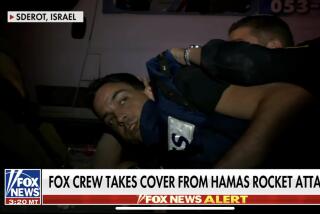Central Command in Qatar Gets a Glossy Briefing Set
- Share via
CAMP AS SAYLIYAH, Qatar — The television stage looks sleek, adorned in muted blues and gray steel girders, the sort of thing Americans have come to expect when they switch on the evening news.
Except this set isn’t at a network studio in Los Angeles or New York. It has been constructed in a warehouse in Qatar where the U.S. Central Command has its desert headquarters for war on Iraq.
The U.S. military hired a scenic designer and spent $225,000 to put this glossy face on the daily briefings it gives to the international media.
By comparison, during the Persian Gulf War in 1991, Gen. H. Norman Schwarzkopf stood in a hotel ballroom with a pointer, a VCR and little else.
Military spokesmen said the new stage represents an effort to “do all we can to tell the American people what’s going on here.”
But with White House aides dispatched to oversee the operation, some political and media experts wonder if it isn’t an example of the Bush administration trying to polish and spin a controversial war.
“Why do you need a stage to dazzle the viewers?” asked Cinny Kennard, a former network correspondent who teaches journalism at USC. “They might think visuals are important, but it’s really the information.”
The military says it is only trying to warm a relationship with the media that had gone cold, if not downright confrontational, since the Vietnam War.
In the Gulf War, journalists were largely confined to covering the conflict from afar. This time, the Pentagon has allowed hundreds of reporters to travel along with the troops.
Such access could result in embarrassing stories about “friendly fire” accidents or civilian casualties, but the military believes that reporters will also see troops working hard to avoid such mistakes.
“At least we get our side of the story told,” said Maj. Brad Bartelt, among dozens of public affairs officers here at Camp As Sayliyah outside Doha, the Qatari capital. The expensive set is simply another vehicle for telling that story, Bartelt said.
The stage was built in Chicago and sent by Federal Express at an additional cost of $47,000. Designed by George Allison, whose credits include several movies and the set for ABC’s “Good Morning America,” it features a long, stylized world map and glowing digital clocks.
Battlefield footage can be shown on plasma screens behind the podium.
The officers who deliver the briefings will have professional lighting and will be shown from measured camera angles. Camouflage netting was recently hung so cameras would not see a blank, white wall in the background when they cut to a side view.
“The face of war has changed, and so has the American public,” Bartelt said. “We’re giving them what they are used to seeing.”
The military learned the value of putting its best media foot forward when Schwarzkopf -- broad-shouldered, straight out of central casting -- became a celebrity.
“He had an impact on how Americans viewed the war,” said Abdallah Schleifer, a former network correspondent who serves as director of the television journalism program at the American University in Cairo.
The White House has dispatched Jim Wilkinson, deputy communications director, to assist the commander of U.S. forces in the gulf, Gen. Tommy Franks, in filling that role.
It was Wilkinson who created the canvas backdrops bearing phrases such as “Strengthen Medicare” and “Corporate Responsibility” that have appeared behind President Bush when he speaks.
The veteran political operative must now deal with more than 550 journalists from around the world.
“There is a connection with what happens on the battlefield and what happens to politicians at home,” said Kenneth H. Bacon, a Pentagon spokesman in the Clinton administration.
“If there are White House people [at Camp As Sayliyah], it shows the White House has a keen appreciation of the impact this war will have on President Bush’s political future.”
With help from Wilkinson and others, Bush has always been conscious of how he delivers his message, political analysts say. But with the decision to build a professional set, the administration might be walking a fine line.
“If it looks too much like a Hollywood production, it could backfire,” said Andrew Kohut, director of the Pew Research Center for the People and the Press. “Especially if they are trying to manage bad news.”
The briefing room has already been referred to as “Dohawood,” and the military seems sensitive to the criticism. Reporters are mildly discouraged from doing stories about the set.
Schleifer, for one, is not offended. “I find it one of the more harmless manifestations of a culture consumed by image,” he said from Cairo.
Bacon, in his current position as president of Refugees International, questions the cost.
“My fear is that they have spent more on the press center than they have spent until the last few months on humanitarian efforts in Iraq,” he said.
More to Read
Sign up for Essential California
The most important California stories and recommendations in your inbox every morning.
You may occasionally receive promotional content from the Los Angeles Times.














